Traditional Methods of Cycad Detoxification in Amami and Okinawa: Historical origins of their biocultural diversity among the islands
Abstract
This article describes the methods of toxicity removal for Cycas revoluta Thunb., used as food on the islands of Amami and Okinawa in the Ryukyu Arc. Regional differences were found in the method of toxin removal from the trunk, which was perceived to make no difference in previous studies. A map showing the geographic distribution of these toxicity removal methods was generated, and the historical origins of the differences in the techniques were discussed. Then, we compared it with the Guam case, where cycads used to be a daily food source. Cycad is still produced as a traditional delicacy in Amami and Okinawa, where cycad consumption was encouraged by the local government, and safe methods of detoxifying the cycad were well known. Beautiful cycad forests can still be seen here and there, especially in Amami. However, in Guam, cycads have been banned since the time of Spanish governors and are not consumed at all. Consequently, they are on the verge of extinction.
Keywords
detoxification, cycad, Amami, Okinawa, Guam, biocultural diversity
1. Introduction
This article presents a study on the consumption the poisonous Cycas revoluta Thunb. in the Amami and Okinawa Islands in southernmost Japan. This study aims to reveal the regional diversity and centuries-long history of diet that includes cycads and their detoxification methods in Japan. Previous studies have found no significant cultural differences. Cycad consumption of Amami and Okinawa residents was compared with that of the Chamorro people of Guam Island, who once consumed Cycas micronesica K.D. Hill as a staple. We examined how the environmental governance of toxic food use differed between the Ryukyu Arc and Guam. The study of traditional environmental knowledge of detoxification techniques may not only shed light on the forgotten history of a staple and famine food, but also aid sustainability though food security and food sovereignty (Ankei, 2023).
1.1. Cycad and its intoxication
Cycads belong to the order Cycadales of Gymnospermae and comprise 375 species across ten genera (The World List of Cycads). They are distributed throughout the tropics and subtropics along the equator (Fig. 1). They are evergreen woody plants that can grow even in poor soils in symbiosis with cyanobacteria and are capable of nitrogen fixation. Most species are toxic and require detoxification before consumption (Ankei & Toyama, 2015).
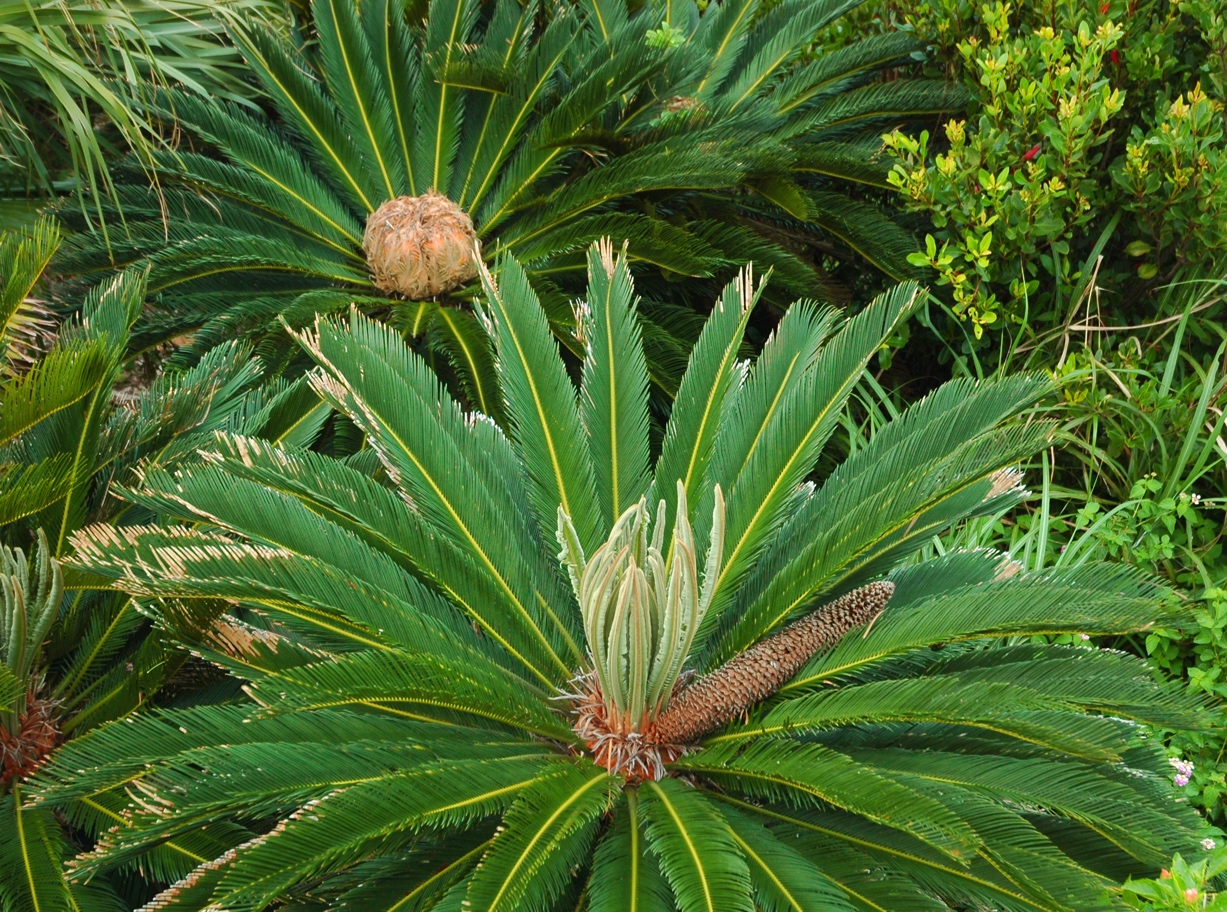
Example of intoxication. Mr. S., a resident of Iriomote Island, first visited and camped in the 1970s when he was a college student. He saw many red cycad fruits (Fig. 2) and asked the children of the island, “Can we eat these?” They replied, ‘Yes!’ He cracked them open, boiled the white endosperm in a rice cooker, and ate them for dinner. They tasted like chestnuts, and since other foods were scarce, he had many of them. In the middle of the night, he experienced severe nausea. He was fortunate to be able to walk to the island clinic on his own. Although the symptoms were not severe enough to require hospitalization, they could have been fatal. The children on the island had no ill intentions and either did not know or had forgotten to inform him that they needed to be detoxified before consumption.
Mr. S., undeterred by this incident, permanently moved to Iriomote Island as a junior high school teacher. From his invaluable experience, we know the following. The toxicity of the cycad fruits persists despite boiling. The taste during consumption does not tell us that they are poisonous. The toxicity occurs within a few hours of ingestion. Mr. S. was able to regurgitate the fruits, which saved his life.
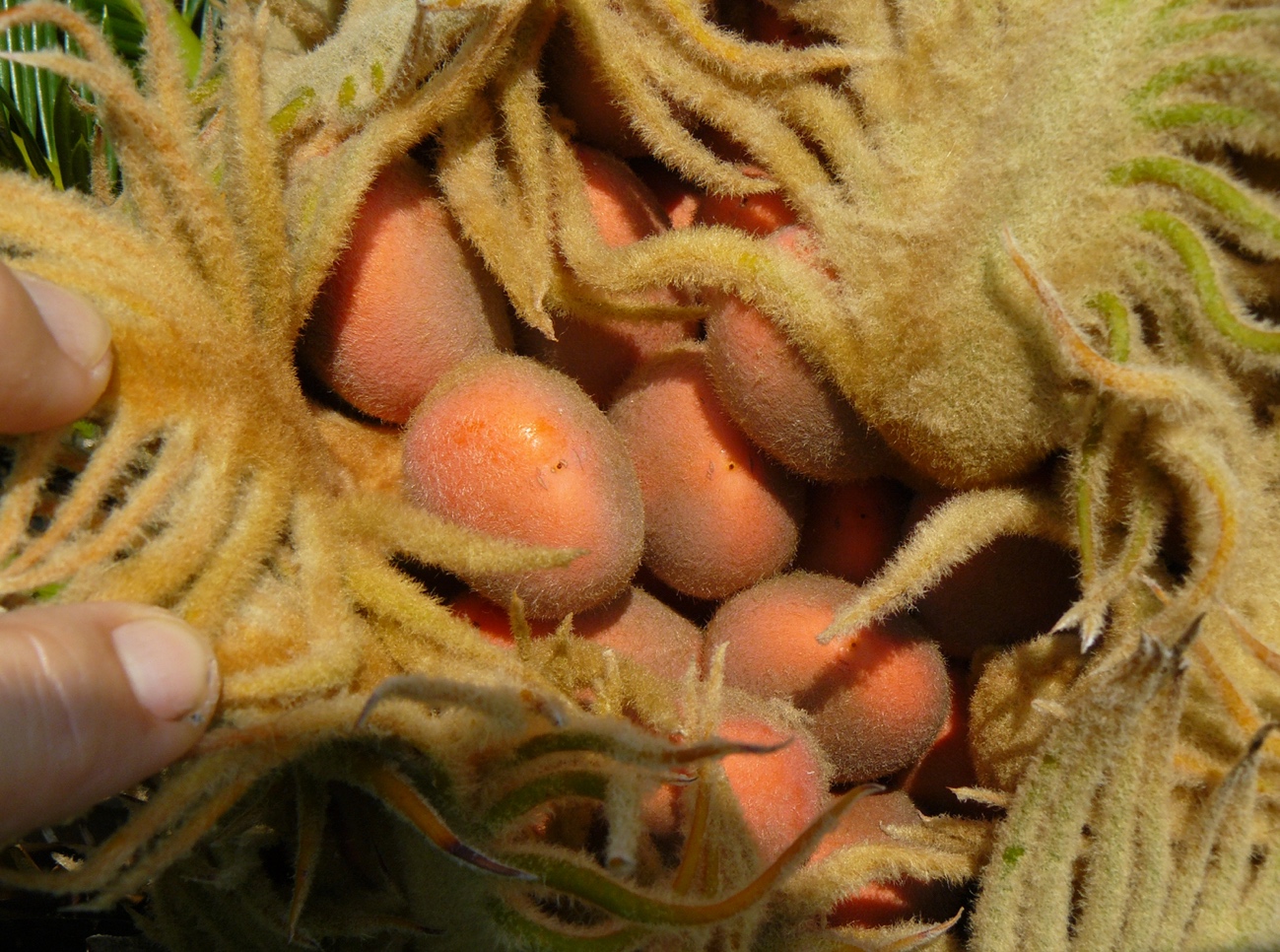
Many deaths occurred in the Okinawan Islands during World War II due to cycad intoxication among soldiers from Mainland Japan who had little knowledge of their toxicity and the process of detoxification. I have heard of such cases in Tokashiki in the Okinawa Islands and Taketomi in the Yaeyama Islands.
The toxic component of cycads is a glycoside known as cycasin, present in the intestine (Nishida et al., 1955).
(1) The enzyme β-D-glucosidase in microorganisms decomposes cycasin into aglycones (non-glycosides) by removing the sugars, giving the product methylazoxymethanol.
(2) Methylazoxymethanol readily decomposes into formaldehyde and diazomethane. Diazomethane (CH₂N₂C) is unstable and decomposes into water, carbon dioxide, and nitrogen in the presence of water.
(3) Formaldehyde causes acute toxicity when consumed. Methylazoxymethanol and diazomethane are carcinogens.
1.2. Research methods
Toxic foods require appropriate processing to be turned into safe products. Once a method for removing toxicity is discovered, it can be propagated. I conducted a comprehensive study on the methods of eliminating cyanide toxicity from cassava, a cultivated plant brought from South America to Africa after the 16th century, based on field research in various parts of Africa and historical and ethnographic sources (Ankei, 2023). The results indicate that such methods, not safe by arbitrary methods, were preserved and the pace of change was slow. Therefore, it was a valuable clue for reconstructing the propagation history of cultivated plants and their processing techniques.
There have been many reports on cycad detoxification and cooking methods in Amami and Okinawa. The content was varied, and the methods were different. Therefore, I will apply my research method for cassava toxicity removal (Ankei, 2023) to cycads. In other words, it is crucial to carefully evaluate each cooking process based on the basic principles of removing toxic ingredients without being confused by the apparent diversity of cooking methods.
I will utilize the following four methods of research: 1) search for biological characteristics of cycads and archaeobotanical materials from archaeological sites for anything related to their use, 2) critical reading of historical documents and local traditions linked to cycads, 3) detailed documentation and analysis of folklore on cycad utilization based on the principles of the study, and 4) participant observation and experimental replication of traditional techniques for detoxification.
2. History of the introduction of cycads into the Ryukyu Arc
2.1. History Revealed by Plant Remains: An Archaeological Perspective
Recent excavations have revealed that cycads existed in Okinawa 5,000 years ago (Kinoshita, 2015: 45). The cycad fruit was excavated at the Ireibaru site in Chatan Town, where long-term human activities from 7,000 years ago to the 1940s were preserved. ‘Acorn mounds’ were found in the layer dated 5,300–5,000 years before present. They excavated Quercus miyagii, Quercus phillyraeoides and Castanopsis sieboldii from these acorn mounds. Acorns of Quercus miyagii containing tannins were excavated from a basket in a spring-fed wetland. This indicated that water leaching occurred.
2.2. Perspectives from biology
Mr. Yoshiyuki Maeda (1947–2017) was a professional gardener involved in studying and selling cycads in Amami for years. When he bundled cycads for shipment, the Amami cycad leaves were resilient to bending, whereas the southern varieties from Miyako and Yaeyama broke. This statement prompted Kyoda & Setoguchi (2010) to conduct DNA analysis of Cycas revoluta from Amami and Okinawa. They found that the species was genetically divided into two populations: the one in and to the north on Okinoerabu Island and the other in the south on Yoron and Okinawa islands. They also found that cycads from southern Kyushu to Yonaguni Island in the Ryukyu Archipelago had significantly lower genetic diversity than the Taiwanese cycad, Cycas taitungensis Shen, Hill, Tsou, & Chen (Kyoda & Setoguchi, 2010). They speculated that this was due to a bottleneck effect, in which the lower islands of Amami and Okinawa were submerged during the Quaternary interglacial period, resulting in the loss of genetic diversity.
Cycads are water-dispersing plants, and fruits are carried by waves and currents and can germinate and grow near water without human intervention. Crows are also often seen carrying fruit; some cycads have germinated and established inland (for example, in Oku village on the island of Okinawa). Thus, I do not deny that some cycads found on the islands of Amami and Okinawa are naturally distributed, as assumed by Kyoda & Setoguchi (2010). However, in later periods, after cycads were used for foodstuffs and other purposes, many were relocated and planted by humans across the islands. Let us examine this from the perspective of the cycad use history.
2.3. Evidence from historical documents and oral traditions
Table 1 provides a brief history of the introduction and propagation of cycads in the Ryukyu Arc. It is based on the authorized history of the Ryukyu Kingdom, like Kyūyō (球陽), local historical documents, and oral traditions collected by folklore researchers and myself.
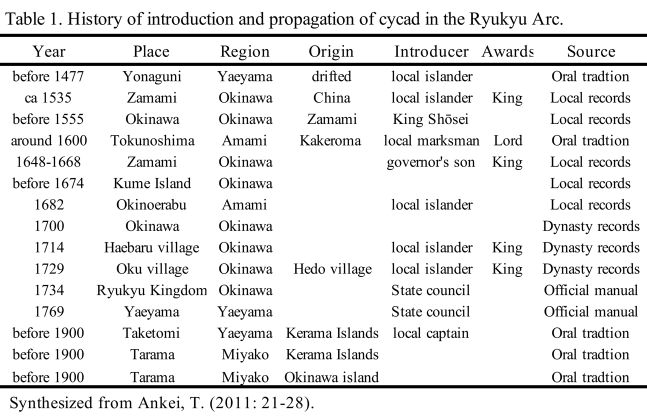
In the official records of the Ryukyu Kingdom, the earliest was 1700. According to some local historical records, much earlier, around 1535, cycads were introduced from China to Zamami Island, and soon after, they began to propagate to Okinawa Island to the east. Since it was helpful as a famine food, islanders who contributed to its propagation were awarded by the king’s administration. Local records tell us that it was planted as food on Kume Island to the west in 1674 and arrived at Oku village, at the northern end of Okinawa Island, in 1729. It took over a century to be widely planted on Zamami Island and about two centuries for the much larger Okinawa Island. Local records are scarce for Amami, and Okinoerabu Island seems to have been the first to plant cycads. In 1734, the chief counsel of the Ryukyu Kingdom, Saion (蔡温), compiled a Manual for Agriculture to be distributed in each majiri (county) and ordered that every farmer should plant cycad. Its version for the Yaeyama Islands in the south was published in 1769.
Saion’s Manual for Agriculture, compiled in 1734, promoted cycads as a good supplement for bad harvests, and since people often died after consuming them, he wrote a supplementary manual on how to properly process them, which was also published in 1734 and distributed to each majiri. He collected experiences from Tonaki Island, Haebaru Village, Oroku Village, and Shikina Village on Okinawa Island; the names of the relevant speakers are acknowledged in this supplementary manual.
Oral traditions usually have no fixed date but constitute the traditional environmental knowledge (TEK) of communities. For example, on Yonaguni Island, an oral tradition holds that islanders first planted cycad fruits drifted by ocean currents. When three shipwrecked men arrived in Yonaguni from an unknown place long ago, the islanders had already eaten cycad fruits but concealed that it was edible for fear of accidental intoxication by foreigners. These three men were identified as Jeju Islanders shipwrecked in 1477 whose experience was recorded in detail in the Annals of the Chosun Dynasty (朝鮮王朝實錄). Since the oral tradition and the corresponding historical record coincided even in small details (Ankei & Ankei, 2011), we arrived at a conclusion that Yonaguni would be the oldest place where people remembered the consumption of cycads in the Ryukyu Arc.
When we visited Zamami Island to the west of Okinawa Island, a local tour guide showed me a plot of land called ‘Ama’s sacred compound.’ Ama was the name of the man who planted the first cycad there, which he brought from China. The cycad planted on that plot is said to be the ancestor of the cycads now spreading throughout the area. According to the lore, during the repeated famines, no one starved on Zamami Island. When the King of Ryukyu discovered this, he sent an envoy to spread the Zamami cycad to other islands.
I also visited the Tete village on Tokunoshima Island, Amami, where the first cycad introduction is said to have occurred. As was explained by a guide, 400 years ago, there was a conquest for marksmanship in the Shodon village, Kakeroma Island located to the north of Tokunoshima. A man named Mori from the Tete village won in the contest. The local lord offered him a prize of a gun, but he asked a cycad plant growing there in exchange for the gun. Even today, a large cycad tree grows in his compound, and shows us how cycad has been important for the inhabitants.
Hitoshi Uezu (1987: 178) reported that on Tarama Island, located between Miyako and Ishigaki Islands, there is a variety called the ‘Kerama cycad,’ with long lobes. On the other hand, there is also a variety called the ‘Okinawa cycad,’ which has short lobes. The name ‘Kerama cycad’ is said to derive from their trunks being imported from Kerama.
Similarly, in Taketomi, on the Yaeyama Islands, there is an oral tradition of introduction from other islands. The captain of a ship that carried taxes to Okinawa Island brought back a variety of cycads from the Kerama Islands. Since then, there has been no food shortage on Taketomi Island, even during the famines. The island’s elders have passed down the achievements of the captain to the children by feeding them porridge made from the tasty glutinous rice-like cycad from Kerama Island. Even today, his descendants honor the soul of this captain, called the Great Master Matsumine, by enshrining his spirit and praising his achievements (Uesedo, 1976: 46–47).
3. Analysis of traditional methods based on the principles of detoxification
An examination of interviews and records from areas where cycads have been consumed revealed diverse and complex operations. We organized and analyzed them based on the characteristics of the toxic ingredients and morphological features of cycads. These results were checked against the principle of detoxification. Cycads were collected from Aguni Island in Central Okinawa and Taketomi Island in Yaeyama. I used water leaching and aerobic fermentation by mold as a detoxification method by learning from the local people. As a result, I understood better why various seemingly complex operations were necessary.
3.1. Morphological characteristics of trunks requiring different processing methods
The cycad stores most of its starch in the seeds and the trunk’s interior. The seeds and trunks differ in structure, starch storage status, and the season starch is stored. The seed comprises a seed coat (consisting of a red, soft outer layer and a hard inner layer), a small embryo, the future bud, and an endosperm that stores starch.
From the outside to the center, the trunk comprises a hard bark-like epidermis, cortex, vascular bundles, and pith, with the cortex and pith containing the most starch. The bark-like epidermis (the ‘black claws’ of Saion) is not edible because it has very little starch. Removing this part is a difficult task. The inner cortex (the ‘white claws’ of Saion) is slightly softer. It requires skill to be removed using a blade because its inner vascular bundles are mostly fibrous and produce sticky mucus. The central pith is less fibrous, homogeneous, starch-rich, soft, and easy to process (Figs. 3 and 4).
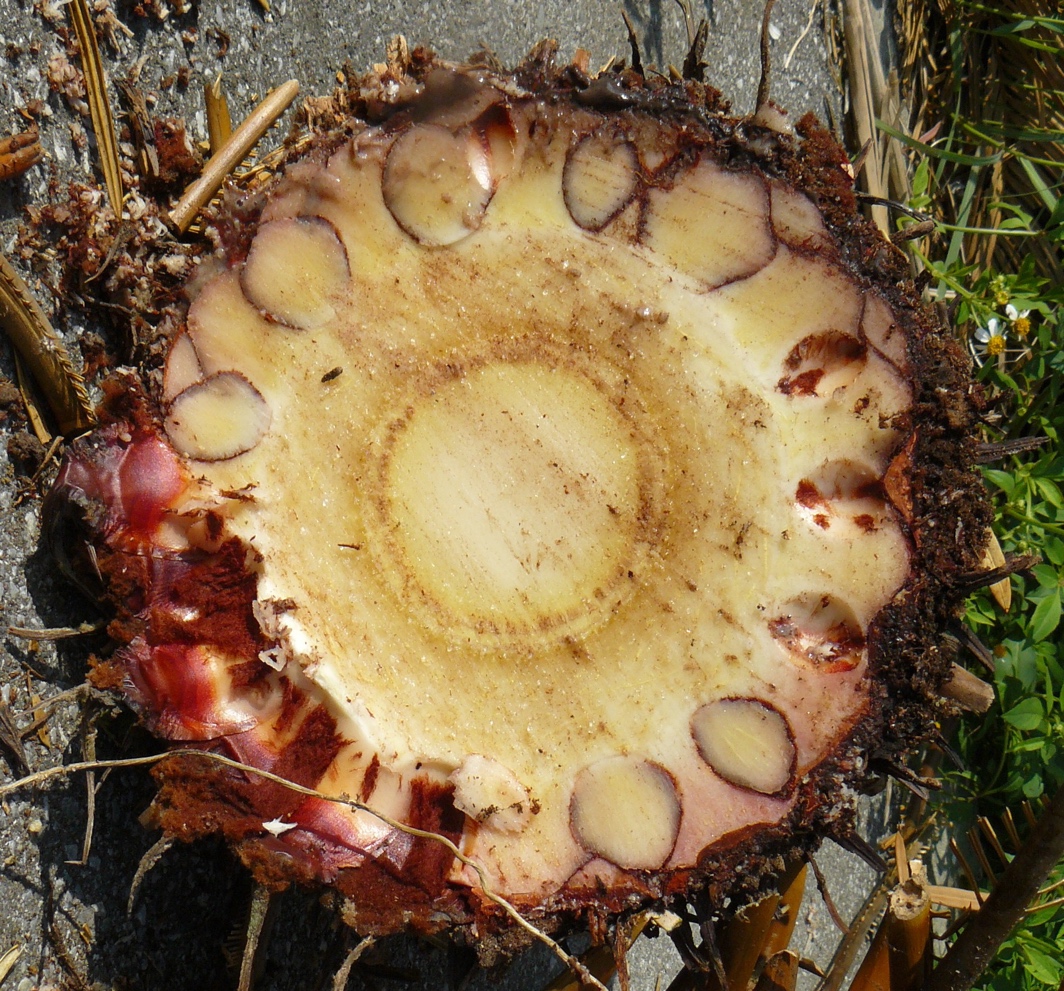
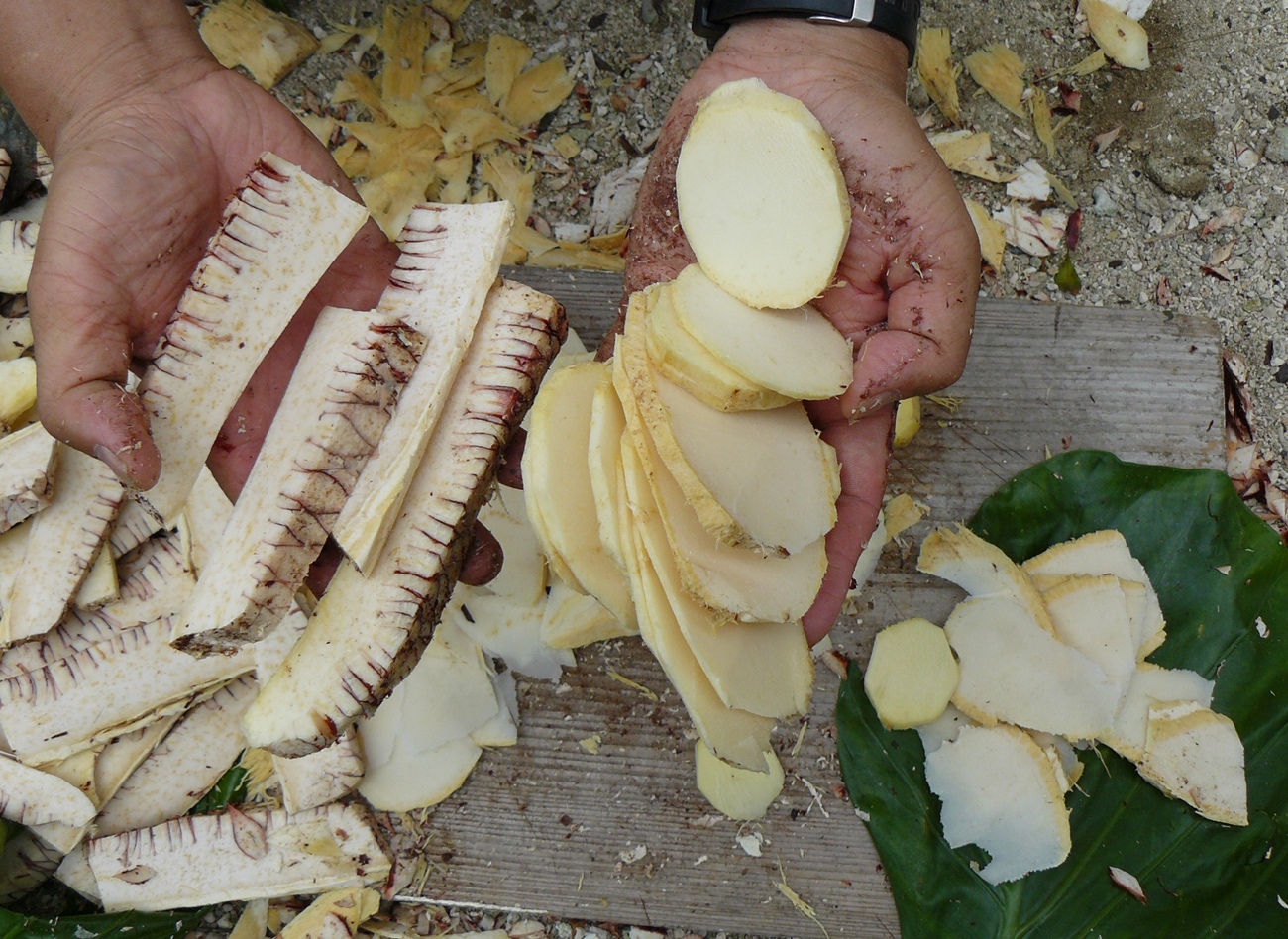
The specific processing method used depends on the structure of the trunk and the nature of each part. Therefore, Saion’s Manual for Agriculture describes each part separately and in detail. Modern people may wonder why they consumed parts that were difficult to process. However, we need to understand that cycads in those days were a food source for rescue in the case of famine, and therefore, all the edible parts had to be consumed.
3.2. Types of detoxification methods based on their principles
The Japanese cycad (Cycas revoluta Thunb.) stores starch in seeds and trunks. The entire plant contains cycasin, which is a toxic glycoside. Cycasin is decomposed into methylazoxymethanol, an aglycon that has lost sugar due to β-D-glucosidase activity (Nishida et al., 1955). Methylazoxymethanol decomposes readily into formaldehyde and diazomethane. Formaldehyde is toxic and can cause poisoning when consumed, whereas methyl azoxymethanol and diazomethane are both carcinogenic.
As was explained in the Introduction, anyone who consumes Cycas revoluta with inadequate detoxification must be prepared for acute intoxication from cycasin and the risk of cancer owing to its chronic toxicity.
Cycasin and formaldehyde are water-soluble, whereas diazomethane (CH₂N₂) is unstable and easily volatilizes upon heating. They react with moisture and decompose into water, carbon dioxide, and nitrogen.
Thus, the detoxification procedure includes (a) cycasin leaching into water, (b) its decomposition by microbial β-D-glucosidase, and (c) removal of the decomposition products of cycasin, formaldehyde, and diazomethane by leaching into water and volatilization. Based on the above method, three detoxification methods are considered effective: leaching into water, fermentation, and heating.
The above three detoxification methods are carried out in the cooking process as follows. Leaching is performed by filling a container with water and changing it repeatedly. Fermentation is performed by piling the cycads and covering them with a straw mat to keep them warm. Aerobic fermentation utilizes microorganisms that grow in oxygenated environments. Boiling before consumption is the final step of detoxification. From the combination and sequence of these processes, I found that in Amami and Okinawa, there are three types of cycad detoxification based on the following procedures:
- Type A: Leaching → heating,
- Type B: Fermentation → leaching → heating, and
- Type C: Leaching → fermentation → heating.
3.2.1. Type A: Leaching
This is the simplest method for removing toxic components using only the principle of leaching before heating.
This method can be regarded as a method of seed detoxification. This is likely because the fruit has almost no fiber and is much easier to pulverize than the trunk. However, there are some areas where the inner part of the trunk, the pith, which has little fiber, is treated using this method, as will be described later.
In the following sections, I will describe the cooking methods for cycad detoxification in the form of actual recipes.
First, you break the hard shells of the cycad seeds in half. Sun-dry them for one or two days. The starch-rich endosperms inside shrink on drying and you can easily remove the shells (Fig. 4).
Crush the material into smaller pieces, place it in water, and leach out cycasin.
(1) Crushing into smaller pieces. Sun-drying makes crushing easier. Crush the endosperm of the fruits with a mallet or pound them into powder. You may also grate the trunks, but it is much harder.
(2) Leaching. Soak the crushed tissue in water to leach the toxic components. Change water several times until it becomes clear. Collect the precipitated starch.
(3) Preserving of the dried starch. Pour the starch into a double-layered bleach cloth bag and drain the water. After drying in the sun, you can store the starch.
Cook the starch in the same way as kudzu starch, into dumplings or porridges.
You may choose not to crush the seeds and preserve them in dried form while maintaining the endosperm form. If so, put the dried product back in water, following steps (1) to (3).
Mold often grows during storage. In some areas, people do not care if mold grows (Masuda, 2003).
The trunk has a rigid fiber structure and a sizeable viscous material. To cut the trunk into pieces, blades such as machetes, axes, and saws are used; however, the trunks are very hard and have mucus that hardens when it dries, making it difficult to cut and impossible to crush, even in a mortar, thus requiring special measures to handle them. Recently, I heard of someone who broke his chainsaw trying to cut the trunk. Only the soft pith in the core of the trunk could be detoxified by simple leaching method.
Therefore, aerobic fermentation with molds was introduced. The mold enzyme β-D-galactosidase decomposes cycasin into formaldehyde and diazomethane. Simultaneously, the mold decomposes cellulose and other substances, softening the fibers and facilitating pulverization. After fermentation, the trunk was placed in water to leach the formaldehyde, decompose the diazomethane, and extract the precipitated starch. Even if diazomethane remained, it decomposed and evaporated while cooking.
3.2.2. Type B: Aerobic fermentation → Leaching → Heating
In this method, trunk sections covered with cellulose or viscous material are first decomposed by aerobic fermentation by the mold to complete the decomposition of cycasin and remove the decomposition products with water.
To ensure successful aerobic fermentation, first reduce the water content to retain heat and regulate the moisture to make the content to ferment well in containers or in bags. After fermentation is complete, crush the starch and fibers. Leach the content in water to separate starch.
The following recipe is based on reports from Amagi Town, Tokunoshima Island (Sakae, 2003) and Toen community, Yamato Village, Amami Ōshima Island (Moriguchi & Ankei, 2009), plus the results of my interviews and participatory observation in Nishiamuro community, Kakeroma Island.
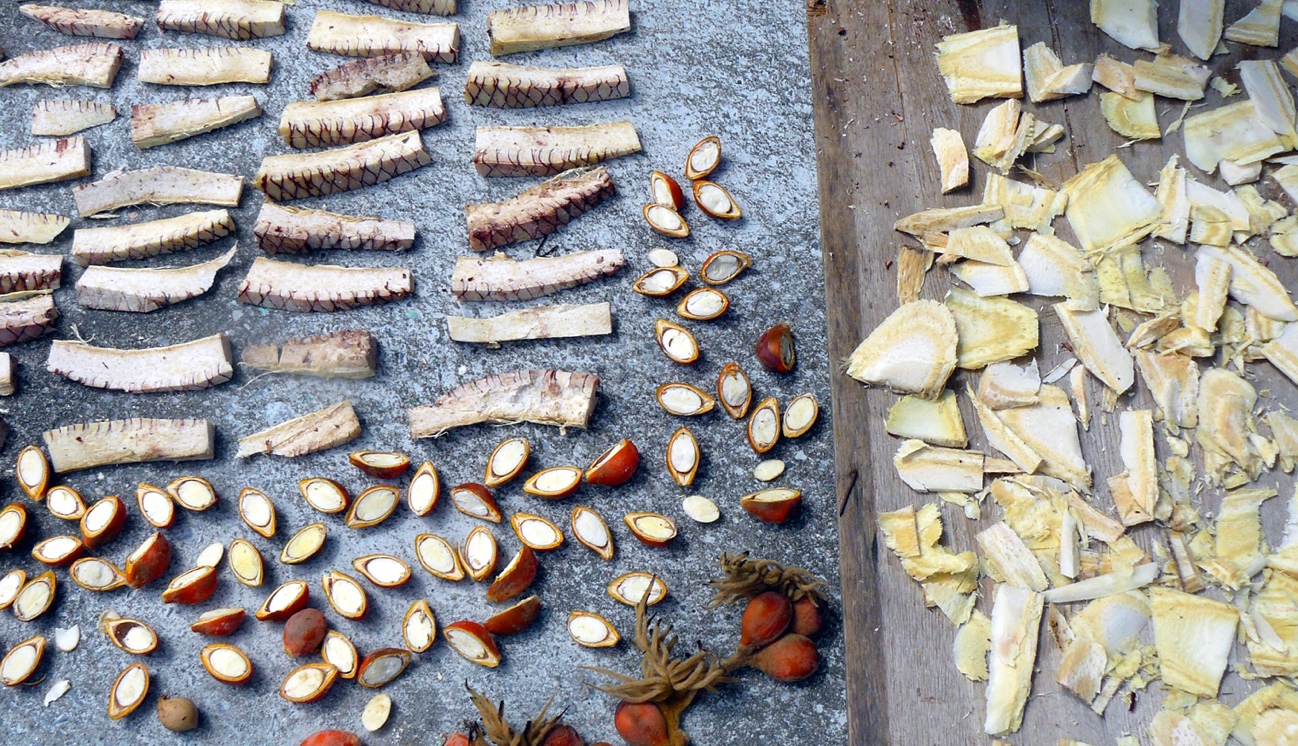
Cycad seeds cracked open (bottom left) and sections of trunk cortex (top left) and pith (right)
(1) Cut the trunks into sections and let them half-dry in the sun for a few days. This facilitates the growth of the fungi involved in detoxification. If there is too much moisture, the bacteria will grow and fail (Figs. 5 and 6).
(2) Create a semi-enclosed space for mold-fermentation. Place straw or banana leaves in a jute bag or basket, place cycads, and cover them with the leaves. Cardboard boxes could also be used for this purpose. Under warm conditions, it will ferment and become hot within three or four days. The growth of mold and a pleasant aroma indicate a successful attempt (my interview in Nishiamuro, 2008).
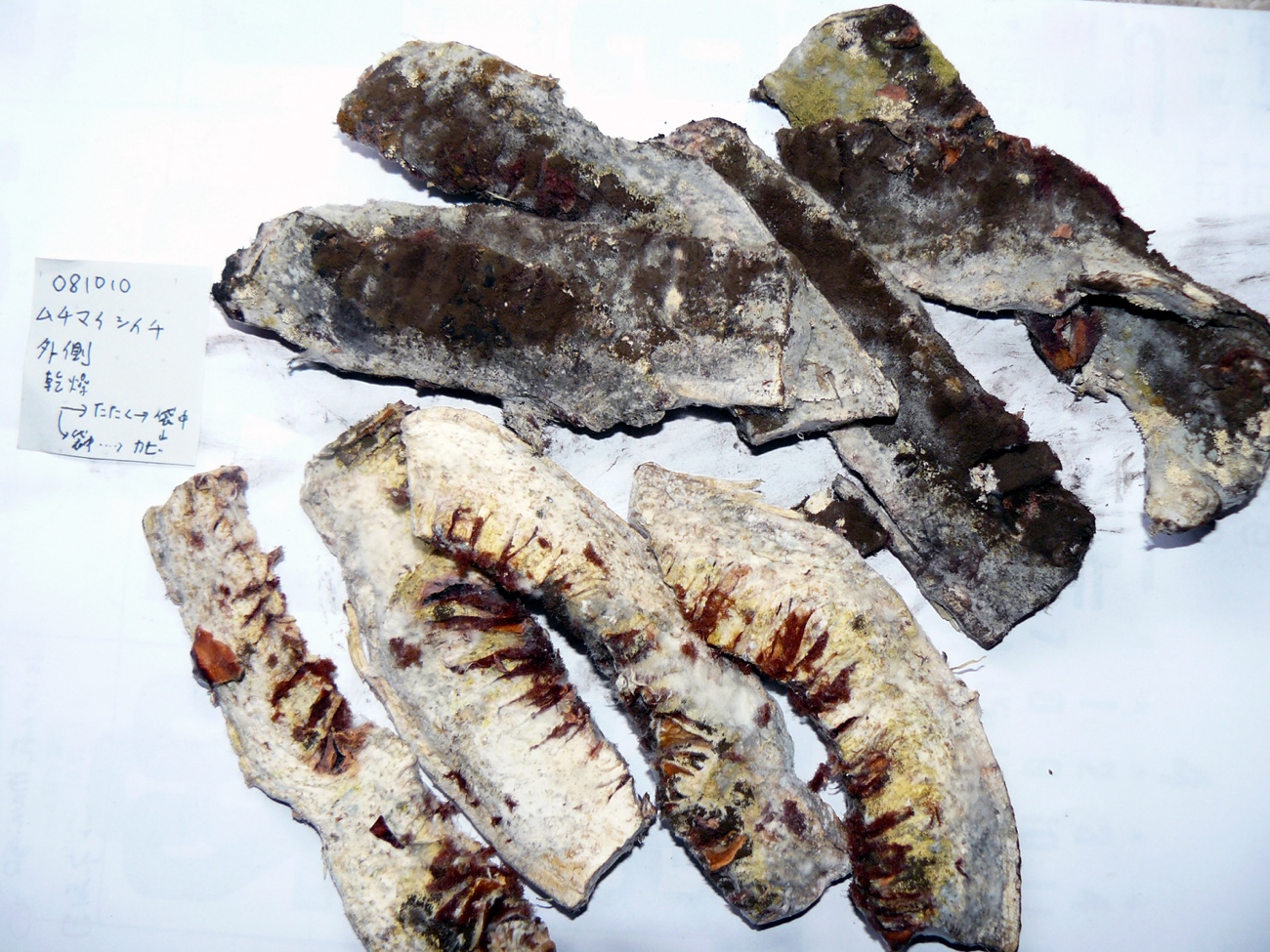
Drying the content for half a day, open the cover once, and then cover it again. At this time, black mold grows. Eventually, the heat decreases. This marks the end of the fermentation process. Fermentation continues until it becomes soft enough to be easily broken by hand. Well-dried cycads in this state can be stored for long periods.
(3) Starch separation via leaching. If the cycad is stored dry, first soak it in water for rehydration. Wash it well with clean water to remove black mold. Crush it in a mortar using a pestle. Transfer the content to a large pot or a bucket. Rub it in the water until starch settles itself. Pass the starch thus obtained through a strainer to remove fibers. Change the water three times until the supernatant becomes clear. Place the content in a double-layered bleach cloth bag and drain well. Make dumplings of the starch and dry them in the sun. The dry dumplings can be preserved (Fig. 7).
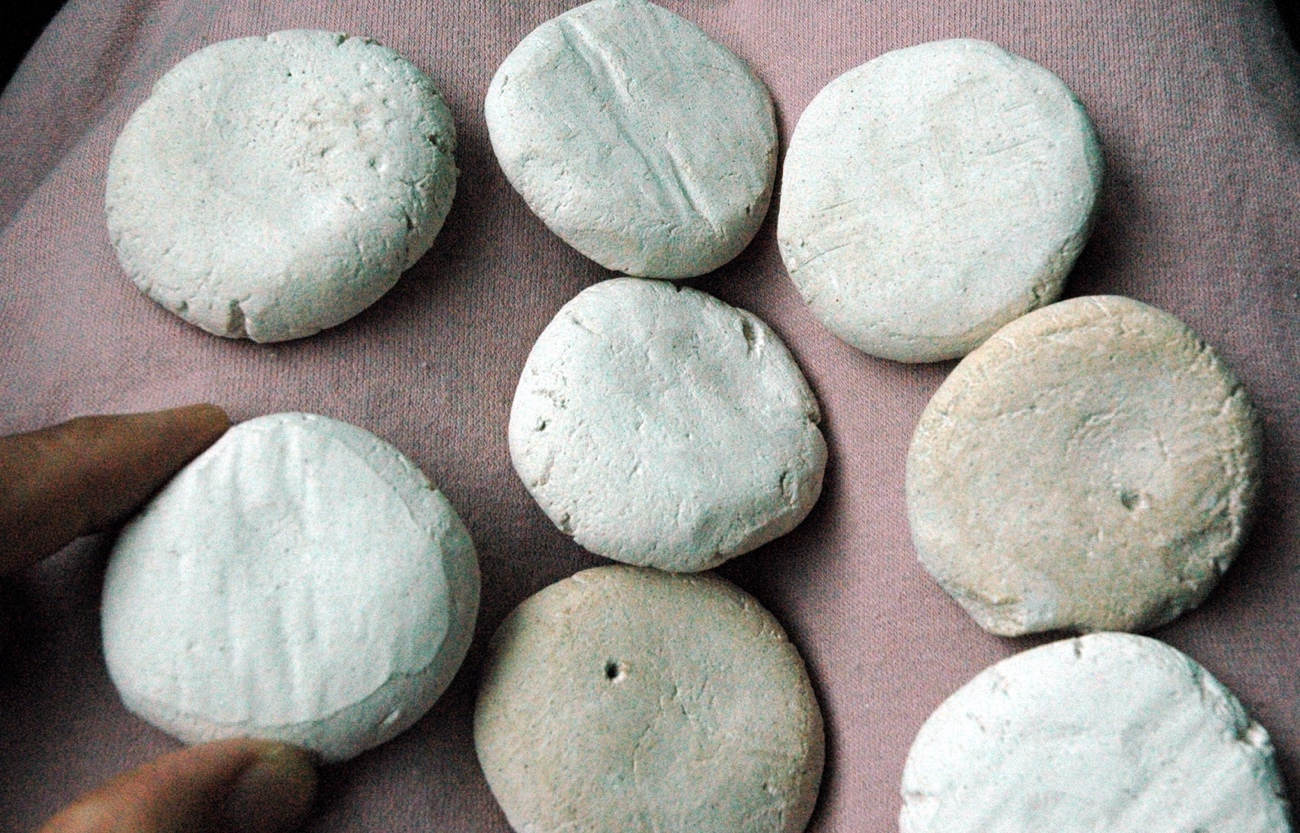
To consume, rehydrate the dried dumplings, break them into pieces, and then cook.

The type B method has been applied to cycad fruits in some regions. In such cases, once the fruit shells are cracked open and the endosperm is extracted, the procedure is the same with the trunks. In Yaeyama, according to the research results of Masuda (2003) on Kuroshima Island and Taketomi Island, and my interviews on Hoshitate, Iriomote Island, the starch of seeds prepared using this method had a blackish finish. People consume them as black as is (Fig. 8).
3.2.3. Type C: Leaching → aerobic fermentation → heating
In this method, the strong cellulose and viscous substances in the trunk are first dried and crushed into small pieces.
First, soak the pieces of a trunk in water to leach and remove the viscous substances. During this process, the toxic component cycasin is also partially removed. Next, the mold decomposes cycasin into formaldehyde and diazomethane via aerobic fermentation. Cook the mixture in hot water for complete detoxification.
This was the method in Saion’s Manual for Agriculture. The same method was also used in the Miscellaneous Stories from Southern Island, which depicts daily life on Amami Ōshima in the end of Edo era. Saion was an outstanding politician who implemented specific policies to make agriculture and forestry sustainable in the Ryukyu Kingdom, where population growth and environmental destruction became serious problems. We are not sure if Saion’s methods were propagated to Amami Ōshima Island even after 1609, when Amami islands were no more ruled by the Ryukyu King.
I will now analyze Saion’s Manual for Agriculture’s method of cycad processing. In 1734, Saion notified each majiri (county) in the Ryukyu Kingdom to prepare for the famine by planting cycads as a rescue food source. His Manual for Agriculture was published in 1734. And its supplement (No. 3) described the safe consumption methods. The techniques described were very detailed, but also were quite complicated.
The following is an example of his explanation for the consumption of cycad trunks. The inedible ‘black claws,’ ‘white claws,’ inner cortex, and core are described separately from the outside to the inside of the trunk. I quote the part of processing the ‘white claws’ as follows (Saion, 1984: 203). The original text had no paragraphs, but for the convenience of my explanation of the essential detoxification process in this text, I have divided it into the following 16 paragraphs.
The processes (1)–(3) correspond to the preparation for leaching, (4)–(5) to leaching in water, (6)–(12) to aerobic fermentation, and (13)–(16) to cooking for consumption. These processes will be further discussed in the section 4.3.
- (1) Scrape off the outer ‘black claws’ on the cycad trunks.
- (2) Scrape off thin layers of inner ‘white claws’ and collect them.
- (3) Dry them in the sun for 7 or 8 days and knock off the dusty parts.
- (4) When they are dried enough to snap off with hands, fill a container with fresh water and soak the shaved ‘white claws’ in it.
- (5) Change the water every day, and after about four days, take out the contents and wash well.
- (6) Remove the water and pile them up in the sun.
- (7) Place them in a straw container, a bale, with a banana leaf underneath. Cover it with a large straw bale called nekobuku, small straw bales, cogon grass, or pampas grass.
- (8) Leave it to ferment for three days, and you will see a yellowish oil-like substance on the surface.
- (9) At that time, take out the contents and expose them to the sun for about half a day, or to the wind if the weather is cloudy.
- (10) Then put them back in the bale.
- (11) Repeat this procedure two or three times, and in six or seven days they will be completely ‘rotten’.
- (12) Some of them will be soft like boiled sweet potatoes and will break easily, while others will still be hard and unbreakable.
- (13) When they become soft and can be easily broken, you can now consume them.
- (14) You may gather the soft parts and boil them for consumption, or dry them and consume them later, or prepare them into flour and preserve them.
- (15) You may cook the cycad flour alone or mix it with rice, millet, barley, soybeans, sweet potatoes, etc. for consumption. Cook and consume according to your taste.
- (16) If the hard part does not break easily, put it back in the bale and let it ferment, and when it softens and breaks, take it out and consume it.
4. Distribution of detoxification types
By combining historical documents, municipal and community histories, and various research results with my fieldwork, I synthesized the geographical distribution of the types of detoxification by applying a typology based on the principles of detoxification. The results revealed the following findings.
4.1. Type A is found in two-thirds of the locations as a method of seed detoxification
Type A is the most widely used method for seed detoxification. This type was found in 25 of the 38 locations (two-thirds). Type B detoxification of fruits was found in seven locations, and type C detoxification was found in two locations. In locations where people did not detoxify fruits in the Type A method, either of the method B or C of detoxifying trunks was applied to fruits. In four locations, both fruits and trunks were processed as type B, and in one location, both fruits and trunks were processed as type C. The fruits and trunks were processed as type A at the other two locations. At four locations, the method of trunk detoxification was described; however, the seeds were only mentioned as “being consumed,” with no further description of the technique of seed detoxification, or the seeds were simply described as “ingredients of miso (fermented soybean paste).” Because repeated leaching procedures can easily remove cycasin in seeds, the record creators likely did not find the need to write down the method again.
4.2. Detoxification methods according to the different materials
The pith of the trunk is detoxified in Type A at three contemporary locations: Geruma, Zamami, and Yonaguni Islands, where the pith is grated before leaching. The interior was washed with water and filtered through a cloth to remove residue. On Geruma Island, pig feed is made from trunks treated using the type C method.
A historical example of Type A was recorded in the Miscellaneous Stories from the Southern Islands (Nagoya, 1984: 82-3) from the end of the Edo period, where the pith of cycad trunks was split lengthwise down the middle and hung over a hedge and left out in the rain for about 10 days. Next, they were pounded with a mortar and leached in a vat, and the precipitated starch was collected and processed using the Type A method. The technique of exposing the pith to rain is exceptional today; however, this likely makes the pith sufficiently soft to be pounded with a mortar.
On Aguni Island, the seeds were processed with the Type A method, while the outer parts, with their hard trunk fibers and high viscous matter, were processed with Type C, ‘Leaching → Fermentation.’ Furthermore, the pith, which is less fibrous and homogeneous in the trunk, was detoxified by type B, ‘Fermentation → Leaching.’ This was confirmed by my observations and interviews and was based on the islanders’ judgment of the material’s properties, such as stiffness and the presence of viscous substances.
Saion’s Manual for Agriculture also treated the pith of the trunk differently from its outside: a careful detoxification method for type C fermentation, followed by another round of leaching. Saion classified the edible parts of a trunk into three categories, calling them ‘white claws,’ ‘endodermis,’ and ‘pith.’ He used the same principle but with slightly different treatment method for each of these three parts.
On Tarama Island, the lye from the ash is used to detoxify the trunks. In Honshu and Shikoku, lye is used to remove the bitterness and harshness of horse chestnuts and acorn saponins; however, this is the only case reported in cycads. Since Tarama Island was an island of political exiles, many intellectuals could have been there, or someone who knew how to remove bitterness from acorns in mainland Japan may have taught it to the islanders.
4.3. Type C as the method of the administrative centers
In 3.2.3., I introduced the detoxification ‘Type C,’ which uses aerobic fermentation by mold after complex pretreatment and leaching. The entire island of Okinawa has been using Type C. On the islands of Zamami and Geruma, which are transit points for ships that brought tribute to China and have a tradition that cycads were introduced from China, and on the islands of Kume, Tonaki, and Ie, which are along the trade route, people have been using this method to detoxify cycads. The Kerama Islands, located between Okinawa Island and China, have been ports of refuge for Ming trade ships since the 14th century.
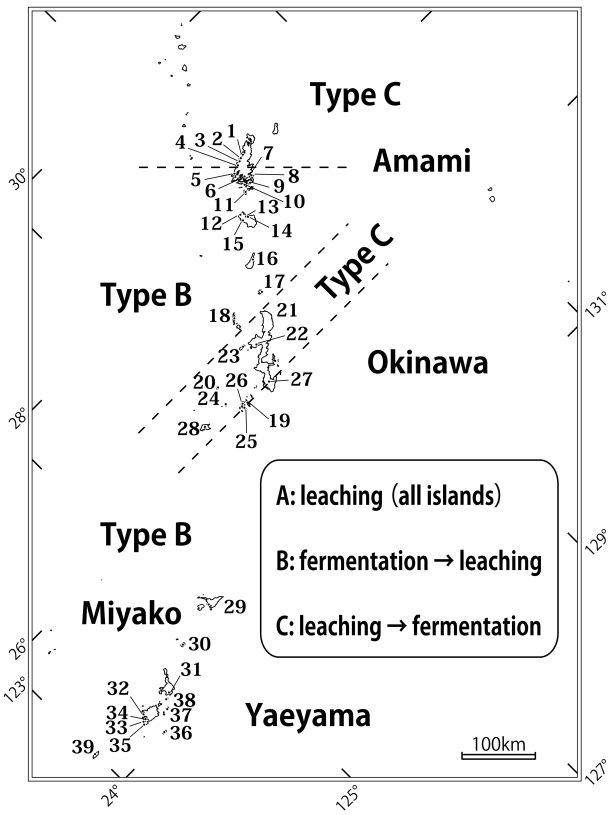
Amami: 1 Koshuku, 2 Nesebu, 3 Yamatohama, 4 Toen, 5 Uken, 6 Adetsu, 7 Seisui, 8 Sokaru, 9 Akitoku, 10 Nishiamuro, 11 Yoro, 12 Kedomi, 13 Tete, 14 Boma, 15 Amagi, 16 Wadomari, 17 Mugiya, Okinawa: 18 Iheya, 19 Tokashiki, 20 Kunigami, 21 Katsuyama, 22 Ie, 23 Tonaki, 24 Geruma, 25 Zamami, 26 Haebaru, 27 Kume, 28 Aguni, Miyako: 29 Hisamatsu, 30 Tarama, Yaeyama: 31 Ishigaki, 32 Hoshitate, 33 Amitori, 34 Funauki, 35 Sakiyama, 36 Hateruma, 37 Kuroshima, 38 Taketomi, 39 Yonaguni.
Interestingly, Amami Ōshima Island, which had been under the direct control of the Satsuma clan since 1609 and was no longer under the political control of the Ryukyu Kingdom after that time, has transmitted the type C detoxification method described by Saion in his Manual for Agriculture.
The description of the Type C detoxification method in the Miscellaneous Stories of the Southern Islands, written after 1855, is very similar to that in Saion’s Manual for Agriculture. The author of this record, Nagoya Sagenta, was punished for political reasons and, in 1850, began to live as an exile in the village of Koshuku, Naze, in today’s Amami City. Table 1 confirms that Type C detoxification was distributed in Naze, a political center near Nesebu and Yamatohama (Osada, 2004: 116–118) in Yamato Village, close to Naze.
4.4 Type B is distributed in the politically peripheral areas of Amami and Okinawa
Type B had a wider distribution than Type C. It is distributed in the Amami Islands, remote from Naze, the political center of administration. Similarly, in Okinawa Prefecture today, it is found on remote islands such as Aguni, Iheya, Tokashiki, Miyako, and Yaeyama.
On the Amami Islands, Type B was not found in the Naze. In Yamato Village, which is adjacent to Naze City, only Yamatohama near Naze is Type C. In other villages, Type B is the conventional detoxification method. The list is as follows. It is practiced in Toen, far from Naze and near Uken Village, Setouchi Town (Adetsu, Seisui, Sokaru), Kakeroma Island, and Yoro Island on the opposite shore of Amami Ōshima. On Tokunoshima Island, the second largest island after Amami Ōshima, according to careful interviews by Hitoshi Uezu (1985), all the villages were of Type B. Okinoerabu Island to the south was also Type B. Tokashiki Island is in the Kerama Islands, where Type C is the mainstream, and was Type B in both my interviews and Masuda’s (2003) report.
4.5 Mechanized detoxification method
Recently, mechanized detoxification of cycads was performed in a small factory in the Akitoku community on Kakeroma Island. After removing the trunk scales, they were cut into large pieces with a machete or axe and soaked in water in a bathtub-sized container to soften. They were then crushed in a grinder and placed in a small room. After approximately 10 or 15 days of fermentation, depending on the climate, the crushed cycad trunks dissolved and melted. They were passed through a sieve to remove the fibers and then leached with water to precipitate the starch. Finally, the contents were strained through cloth and rapidly dried in a dryer at 80°C to obtain the floury product. They sold this product as cycad trunk starch (Fig. 10).
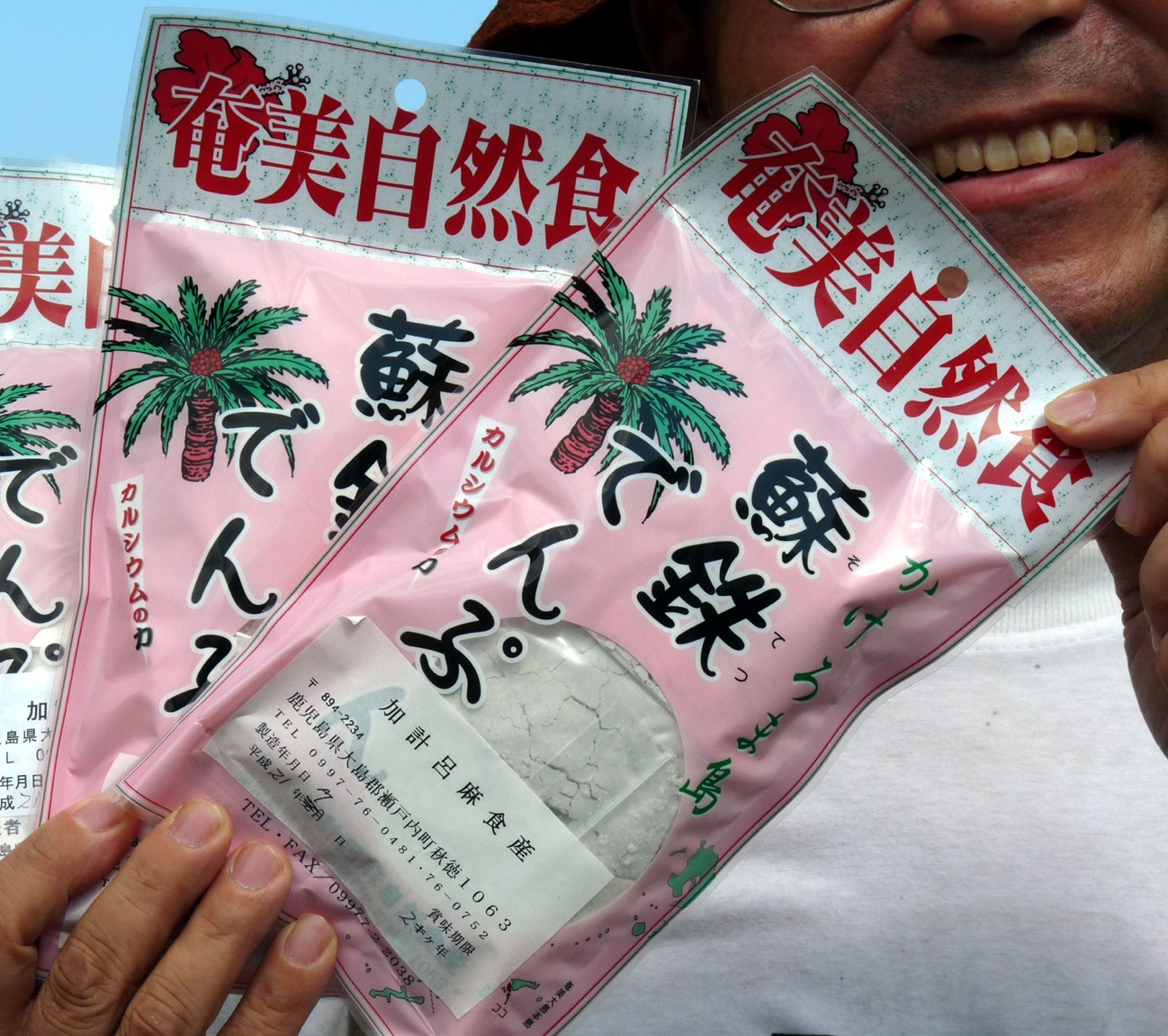
Type B is the traditional method of cycad detoxification used on Kakeroma Island. The mechanized method appeared to have added water soaking as a pretreatment. When we visited the factory, we asked the reason for this. We were told that the viscosity of the trunks is very difficult to deal with when processing a large amount of material at a time, so the trunks were soaked in water to reduce their viscosity and soften them before being crushed by the machine. Homogenization of the material by crushing ensured detoxification during subsequent fermentation. This fermentation decomposes cycasin, and the resulting formaldehyde and diazomethane are leached into the water and removed. In addition, to prevent mold from forming on the detoxified starch, they machine-dry it at a temperature of 80°C. This final heating process also decomposes diazomethane. The list should be labeled ‘Type B+,’ which adds water exposure before the Type B detoxified method. This may also be referred to as Type B+C. This differed from Type C because there was no drying at the beginning.
There is an increasing demand for cycad trunk starch. Mr. Tokuda Mitsuo, the starch manufacturer, showed me a letter from a medical doctor. It was a request for his cycad starch, saying that one of his patients at the terminal stage of cancer, who no longer accepted oral nutrition, could enjoy the porridge made with this cycad trunk starch.
In conclusion, we now know that there have been two types of traditional methods of cycad detoxification of their trunks. Their geographical distribution seems to be related to their distance from the political centers. Is it possible to understand this distribution in relation to the route and timing of the introduction?
In this article, I have revealed the existence of two traditional methods of cycad trunk detoxification in Amami and Okinawa. Environmental governance by the administration centers seemed to have influenced their geographical distribution. I also compare the environmental governance of another cycad-consuming island, Guam.
5. Discussion
5.1. Cycad cultivation as part of environmental governance from above: Cases from Okinawa
Saion, the Prime Minister of the Ryukyu Kingdom in the first half of the 18th century, ordered the islands of Okinawa to plant cycads for food. He instructed the establishment of a ‘Plot for cycads’ in each village. While Saion promoted the cultivation and use of cycads for subsistence consumption, he strongly encouraged the cultivation of newly introduced sweet potatoes. The two policies had a common goal of ‘storage’ as described below.
The text of Saion’s Manual for Agriculture consists of six sections, one of which, ‘saving,’ contains the following three items (Saion, 1984: 198).
In a year with a bad harvest, not only is the farmer unable to pay tribute, but he also goes hungry. This is due to a lack of savings. To save, it is important not to incur extra expenses or save a little each year; therefore, they are not careless. In a bad harvest, cycad is especially important as a food supplement; hence, plants are increasingly used. The processing method is described in a separate book, following the instructions.
If you have extra sweet potatoes, dry them, and store them as a staple. The method for drying and storing sweet potatoes will be written in a separate book during the year of the boar; please follow the instructions.
Following these storage instructions, the planting of cycads and methods for preserving and storing sweet potatoes are described.
Traditionally, sweet potato, introduced to the island of Okinawa from China in 1605, was incorporated into the lives of the Okinawan people, who were constantly plagued by typhoons and droughts, and its cultivation quickly spread throughout the island, becoming the main crop for farmers (Arashiro, 2001: 117). This occurred only 10–15 years after its introduction (Machida, 1980; Miyagi, 1972). Cycad is an insurance policy against severe starvation when the sweet potato supply is low. Cycads, which grow in steep or rocky areas, unsuitable for cultivation of other crops, and possess large amounts of starch in their trunks despite their slow growth, are essential stockpiles that can help the residents cope with famines, which occur once every few decades (Ankei, 2011).
Arashiro (2001:104) describes the life of Ryukyuan farmers in the early modern period: the farmers were burdened with taxes and struggled to maintain a minimum standard of living. In the 18th century, abnormal weather, such as typhoons and droughts, occurred frequently, resulting in famine and disease, and many people died from starvation. As a countermeasure, Saion’s Manual for Agriculture encouraged planting cycad. A Manual for Agriculture in Yaeyama was also issued for the Yaeyama regions. In addition, the royal government awarded farmers who planted many cycads.
The policy of ordering the common people to plant cycads all over the islands without exception had to be accompanied by careful dissemination of knowledge on safe processing methods to avoid poisoning since the more people ate cycads, the more likely they were to become addicted to them.
Specific and detailed knowledge was obtained from the people of Tonaki Island, Haebaru, Oroku, and Shikina villages on Southern Okinawa Island. The names of the people who provided examples of cycad detoxification practices are included in the Supplementary Volume. The description of the cooking method of cycad found in Saion’s Manual for Agriculture Supplement No. 3 was the result of Saion’s efforts to build environmental governance based on traditional environmental knowledge (TEK). He understood the importance of TEK among common people. He interviewed local people about local poison removal techniques and propagated records containing the names and origins of the TEK holders. This illustrates Saion’s greatness as a politician in promoting environmentally friendly policies (Miwa, 2011; 327–331).
5.2. Cycad cultivation as part of environmental governance from below: Cases from Yaeyama
However, the situation is different in Yaeyama. On the side of the common people, there were the circumstances of the common people. Without encouragement, instructions, or orders from the top, ensuring the quantity and quality of daily meals was the primary concern of households, and waiting for instructions from Okinawa Island to reach Yaeyama was not possible for a slow-growing cycad.
It has already been mentioned that the people of Yaeyama and Tarama Islands heard of a good variety of cycads on Kerama Island and took various measures to pick them. Tokunoshima’s cycad, the second largest of the Amami Islands, was brought from Kakeroma Island and spread.
These are the legacies of the introduction of cycads, comparable to the efforts of our predecessors who brought and spread sweet potatoes. They have been handed down to this day as the fruits of efforts to improve people’s lives from the bottom up.
Saion’s Manual for Agriculture describes the Type C method in this study; however, in the Miyako and Yaeyama areas, the trunks were detoxified using the Type B method. In his description, both seeds and trunks were detoxified using the same type B method, and seeds were detoxified using the type A method. This is also the case in Hoshitate, on western Iriomote Island. On Kuroshima and Taketomi Islands in Yaeyama, seeds are consumed after being detoxified with type B method. As a result, black mold grows on them, and the finished dish is black. They say, “The more mold, the better it tastes,” and “there is a special flavor in the mold” (Masuda, 2003: 84, my interview on Taketomi Island).
5.3. Relationship between the two environmental governance systems
The geographical distribution of the type C detoxification of cycad has been biased toward political centers such as Naha and Naze. It seems that the type B detoxification had been widespread as a native method, when type C method was newly introduced in political centers as an innovation. However, it is not the case that type B is less efficient than type C as a technique for detoxification. Even if a new variety of cycad arrived from a type C detoxification area, as is the tradition on the Tarama and Taketomi Islands, the detoxification method in Yaeyama remained unchanged (type B). People did not readily accept the new method. There were two reasons for this: one was taste, as seen on Kuroshima Island, where “cycad covered by black molds tastes good,” and the other was processing technology, as seen on Yonaguni Island, where good quality iron blades were difficult to obtain until the prewar period (Ankei, 2007). On the Yaeyama Islands, where wooden hoes and stone tools were commonly used, Type B, which uses fermentation to soften hard trunks, would have been less labor intensive than Type C, which requires careful scraping of the hard trunks.
The division between ‘wise use’ and ‘unwise use’ of the environment and limited resources is an important focus on the extent to which environmental governance is coordinated (Yumoto, 2011). The public did not easily accept the recommendations from the central government lest they fit the local environmental governance and the traditional preference for taste.
If Saion had had the opportunity to observe the lives of the people in Miyako and Yaeyama, he would have noticed the excellent taste of ‘black cycad,’ produced by the Yaeyama-style indigenous detoxification method. Moreover, during his reign, he would not have made countless victims of his failed environmental governance, such as forced migration to fatal malaria-infected areas in the Iriomote and Northern Ishigaki islands (Tajima & Ankei, 2011).
Thus, the geographical distribution of cycad detoxification types indicates that two directions of environmental governance coexisted: ‘from above’ or from the ruler of a wide area like the Ryukyu Kingdom, and ‘from below’ with each household or village society as a unit.
5.4. The case of Amami: Cycad as the major staple
In the 17th century, Okinawa and Amami had different political systems. Okinawa continued to be the Ryukyu Kingdom, a puppet government ruled by the Satsuma clan. It was allowed to trade with China even during the Edo period, when trading was restricted to Nagasaki, Tsushima Island, and Matsumae in today’s Hokkaido. The Amami Islands, once belonged to the Ryukyu Kingdom were under direct colonial rule of the Satsuma clan. On the Amami Islands, sugarcane cultivation was forced on arable land. Most of the rice fields were transformed to sugarcane fields. Steep slopes were for sweet potatoes to feed local commoners. And the remaining barren lands were turned into cycad plots. Since the payment of sugar as tax was very severe, about half of the inhabitants were landless, and became yanchu, or serfs subordinate to land owners. The daily consumption of these yanchu was mostly restricted to cycads. Little is known about the historical records of how governance from the above worked in planting these cycads. In the mid-19th century, Nagoya Sagenta, a samurai, who was sentenced to exile on Amami Ōshima Island made the illustrated account of the daily life of local inhabitants. We can see that a rich diversity of cycad-based food has existed since the end of Edo era until today on Amami Ōshima and its adjacent islands like Kakeroma and Yoro (Nagoya, 1984; Sakae, 2003; Okuzaki, 2008).
In Okinawa, the term ‘cycad hell’ was invented by a newspaper reporter and became famous throughout Japan. The fact, however, was that the real starvation of hell came when people ate up all the cycads as famine food. On the other hand, on the Amami Islands, the inhabitants told me that cycad has always been a benefactor as reliable staple food.
Even after gaining independence from the Satsuma clan, the Amami people, who had consumed cycads daily throughout their long history, were able to continue to process it even during occasional food shortages. In Okinawa, cycad was often consumed only as an emergency food. There were many cases of acute poisoning among people who did not know how to detoxify cycad. The Japanese forces that occupied the region during World War II did not have an adequate food supply for their soldiers, and it was common for soldiers to die from cycad poisoning in Okinawa at the war’s end (Ankei, 2011).
5.5. Cycad in Guam: From official banning to disappearance
Cycas micronesica K.D. Hill is the only cycad native to Micronesia. The Chamorro, the indigenous people of Guam, have a long history of using it as a food source.
In the 1850s, at the end of three centuries of Spanish rule, the governor of Guam instructed the islanders to refrain from cycad consumption. The reason was that it was a toxic food, and there were cases of acute poisoning (Giménez-Roldán et al. 2021: 1). This also demonstrates that cycad was frequently consumed by the Chamorro that time.
In 1904, lytico-bodig, a neurodegenerative disease, was first reported in the medical community of Guam. Among the many theories proposed for the cause of this disease, which medical experts call ALS-PDC, it has been hypothesized that it may be caused by consuming cycad fruits or by consuming the flesh of cycad-eating fruit bats. However, no conclusions have been drawn regarding the etiology of this disease. Currently, there are no outbreaks of this disease, and both cycad and fruit bat consumption have almost disappeared. At the same time, once the dominant vegetation of limestone sites in Guam, cycads have become virtually extinct owing to habitat development and non-native invasive insects, and fruit bat populations have plummeted from approximately 3,000 individuals in the 1950s to the current 40-50 individuals. Some researchers have argued for the revival of biocultural diversity and hope that environmental conservation will lead to a return to traditional consumption by Guam’s people (Marler, 2020).
5.6. A comparison of Amami, Okinawa, and Guam
There was a major difference in environmental governance over cycad consumption from the above, the history of its popularization in the Ryukyu Kingdom, and its prohibition in Guam. Subsequently, both regions shared the same experience of reliance on cycad food consumption to cover food shortages caused by World War II. Residents were forced to rely heavily on cycad as a famine food because of the deprivation of their usual food by Japan’s military fighting in their islands. Postwar Guam, Okinawa, and Amami experienced food shortages until wheat and corn flour were transported to these areas. Residents consumed more cycads through proactive environmental governance to navigate this situation.
Mr. Shōichi Yokoi, a former Japanese soldier who remained in Guam, survived for 28 years by hiding in a cave and consuming cycad fruits, cracked, and leached in river water for four days as his only staple food (Moriguchi, 2015).
In Okinawa, my observations in the Yaeyama Islands show that many of the cycad cultivation plots that Saion once ordered to set up in the villages have been abandoned, and their cycads have been replaced by other fast-growing trees. However, there are many Amami Islands where beautiful cycad forests have been preserved, such as the Kakeroma, Yoro, and Tokunoshima Islands. On Okinawa’s Aguni Island, cycad miso is produced and sold at the island’s ports. Amami cycad miso is also sold at Amami Airport, indicating that cycads remain an iconic local food source. Furthermore, on Kakeroma Island, Amami, a labor-intensive trunk starch manufacturing plant is still operating and selling the product throughout the country.
All three regions were controlled by the United States after World War II. In Amami, the period was short, ranging from 1945 to 1953. In Guam and Okinawa Island, the postwar economy of U.S. military bases led to an increased dependence on imported food. Consequently, cycad food consumption has been rapidly forgotten in these two regions.
Among the Okinawan islands, where cycad consumption declined quickly, some islands have cycad as a regular food, and there are exceptions, such as Aguni Island, where cycad miso is still sold as a specialty product. However, today, older people only remember consuming poorly detoxified and unpalatable cycads during the food shortages that followed the Battle of Okinawa during the war (Ankei & Toyama, 2015).
I believe that the sensational expression ‘cycad hell’ reflected that Okinawan cycad related TEK has long since been lost. In contrast, in Amami, cycads are highly valued, and there are still many sites where cycad vegetation has created beautiful landscapes. However, as I continued my research, I realized that even in Amami, the number of people who know how to process cycads is limited. After the war, the cash economy spread with high economic growth in both Okinawa and Amami, and rice and wheat could be easily purchased from outside the islands. At the same time, the self-sufficient food culture was rapidly lost. People first stop eating cycads, which requires a time-consuming and labor-intensive detoxification process. To document this loss of cycads, I called on my research colleagues to publish a book in 2015 titled Re-evaluating the Cycad: A Cultural History of Cycad in Amami and Okinawa (Ankei & Toyama, 2015). The purpose of this book was to inform the public about the need to prepare for starvation on these isolated islands, as well as about a traditional culture that is too important to be forgotten entirely.
5.7. Prospects
Whiting (1963) pioneered the comprehensive study of cycad consumption worldwide, inspired by her fieldwork in Guam. She surveyed cycads worldwide and found they are used as food, medicine, and poison. Cycads are a rescue food, seasonal shortage/emergency food, and an example of reported cases of consumption and intoxication in humans and animals. She listed varied ways of consuming cycads in the table of ‘Cycad as food for man.’
Encouraged by this global research, I would like to focus my future research on methods for removing poisons from cycads, half-wild tubers of Alocasia (Araceae), and cultivated cassava. This last is a relatively new crop in the Pacific Islands. Further research on TEK is required on how people living on islands have coexisted with poisonous food. This case study of cycad consumption in Japan and Micronesia taught us the importance of comprehensively studying island sustainability from the perspectives of both environmental governance (food security) and grassroot environmental governance from below (pursuit of food sovereignty) as was discussed in Ankei (2022).
Conflict of interest
No conflict of interest is declared by the author.
Acknowledgments
I would like to thank the many people and institutions in Amami and Okinawa for their kind guidance during my fieldwork. The study team for the biocultural diversity in the Ryukyus provided me with intellectual stimulation and encouragement. This research was supported by the Research Institute for Humanity and Nature (RIHN: a constituent member of the National Institutes for the Humanities), the Japanese Archipelago Project led by Professor Takakazu Yumoto, and the Linkage Project (No. RIHN14200145).
References
- Ankei, Takako, 2011. ‘The Routes of Cycad Diffusion: Another Amami-Okinawa History from the Geographical Distribution of its Detoxification,’ In Ankei, Yuji and Masanao Toyama eds., Amami-Okinawa Environmental History Resource Collection, Nanpo Shinsha, Kagoshima, pp. 363–404 (in Japanese).
- Ankei, Takako, 2022. Cooking of the Songola People in the Democratic Republic of Congo: Diversity and sustainability of diet through regional self-sufficiency, Farming Technology and Culture, 31: 47–71 (in Japanese). https://www.nobunken.org/31-2022-1 (retrieved 11 Sept 2023).
- Ankei, Takako, 2023. ‘Diffusion of Cassava Detoxification in Africa: A Reconsideration of its Biocultural History,’ African Study Monographs. Supplementary Issue, 61: 93–138.
- Ankei, Takako & Masanao Toyama, 2015. Re-evaluating Cycads: A record of the cultures of cycad use in Amami and Okinawa, Border Inku, Naha (in Japanese).
- Ankei, Yuji ed., 2007. Agrarian Culture of Iriomote Island: the discovery of routes on the sea, Hosei University Press, Tokyo (in Japanese).
- Ankei, Yuji & Takako Ankei, 2011. ‘Memories of Interchange between the Drifters of Jeju Island and the People of Yonaguni Island in 1477,’ Amami Okinawa Environmental History Resource Collection, Nanpo Shinsha, Kagoshima, pp. 547–576 (in Japanese).
- Arashiro, Toshiaki, 2001. High School History of the Ryukyus: Revised and Expanded Edition, Editing Studio Toyo Kikaku, Tokyo (in Japanese).
- Giménez-Roldán, S., Steele, J. C., Palmer, V. S., & Spencer, P. S., 2021. ‘Lytico-bodig in Guam: Historical links between diet and illness during and after Spanish colonization.’ Journal of the History of the Neurosciences, 1–40.
- Kinoshita, Naoko, 2015. ‘Prehistoric Cycads and Acorns,’ Ankei, Takako & Toyama Masanao eds., Re-evaluating Cycads: A record of the cultures of cycad use in Amami and Okinawa, Border Inku, Naha, pp. 45–48 (in Japanese).
- Kyoda, Shigeharu & Hiroyuki Setoguchi, 2010. ‘Phytogeography of Cycas revoluta Thunb. (Cycadaceae) on the Ryukyu Islands: Very low genetic diversity and geographical structure, Plant Systematics geographical structure,’ Plant Systematics and Evolution, 288 (3–4.: 177–189.
- Machida, Harunaga, 1980. Yoron Island Folk Culture Historical Materials, Published by the author, Kagoshima (in Japanese).
- Marler, T. E., & Shaw, C. A., 2020. ‘Fresh and Dry Weight Relations Are Predictors of Cycas micronesica Seed Age,’ Horticulturae, 6 (2): 29.
- Masuda, Akiko, 2003. ‘Folklore Memorandum on Cycads,’ Journal of Folklore and Culture 4: 79–103 (in Japanese).
- Miwa, Daisuke, 2011. ‘Environmental Degradation and Social Responses in the Early Modern Ryukyu Kingdom: Saion’s resource management policy,’ Amami Okinawa Environmental History Resource Collection, Nanpo Shinsha, Kagoshima, pp. 303–334 (in Japanese).
- Miyagi, Fumi, 1972. Records of Daily Life in Yaeyama, published by the author (in Japanese).
- Moriguchi, Mitsuru & Takako Ankei eds., 2009. Cycads are Benefactors: Life on the Amami Islands, Narratives of Daily Life in Islands 2, Border Inku, Naha (in Japanese).
- Moriguchi, Mitsuru, 2015. ‘Cycad micronesica that Kept Mr. Yokoi Shoichi Alive,’ Ankei, Takako & Masanao Toyama eds., Re-evaluating Cycads: A record of the cultures of cycad use in Amami and Okinawa, Border Inku, Naha, pp. 120–123 (in Japanese).
- Nagoya, Sagenta, Naoichi Kokubu & Hiroshi Era eds., 1984. Miscellaneous Stories on Southern Island, 1 & 2, Heibonsha, Tokyo (in Japanese).
- Nishida, K., A. Kobayashi, & B. Nagahama, 1955. ‘Studies on Cycasin, a New Toxic Glycoside of Japanese Cycad,’ Academic Reports, Faculty of Agriculture, Kagoshima University, 4: 151–168 (in Japanese)
- Okuzaki, Hajime, 2008. Cycad Culture and the Origin of the Islands, Published by the author, Naze (in Japanese).
- Osada, Suma, 2004. My Amami, Kaifu-sha, Osaka (in Japanese).
- Sakae, Kikumoto, 2003. All about Cycad, Nanpo Shinsha, Kagoshima (in Japanese).
- Saion, Gushichan Uēkata, Sakihama Hideaki eds. (1984. The Complete Works of Saion, Honpo Book Publishing (in Japanese).
- Tajima, Yoshiya & Yuji Ankei, 2011. ‘An Epilogue,’ Environmental History of the Sea, Islands and Forests, Series 35,000 Years in the Japanese Archipelago (4), Bun’ichi Sogo Shuppan (in Japanese).
- Uesedo, Tōru, 1976. Taketomi Island Ethnography: Its Folktales and Folklore, Hosei University Press, Tokyo (in Japanese).
- Uezu, Hitoshi, 1985. ‘On the use of Cycads in Tokunoshima Island,’ Tokunoshima Research Report 3, Institute for Southern Island Cultural Studies, University of Okinawa, Naha (in Japanese).
- Uezu, Hitoshi, 1987. Folk Culture of Southern Islands, Hirugi-sha, Naha (in Japanese).
- Whiting, M.G., 1963. ‘Toxicity of Cycads,’ Economic Botany, 17:271–302.
- Yumoto, Takakazu ed., 2011. What is Environmental History? 35,000 Years in the Japanese Archipelago (1), Bun’ichi Sogo Shuppan, Tokyo (in Japanese).
- The World List of Cycads, https://www.cycadlist.org/ (retrieved 3 Sept 2023).
